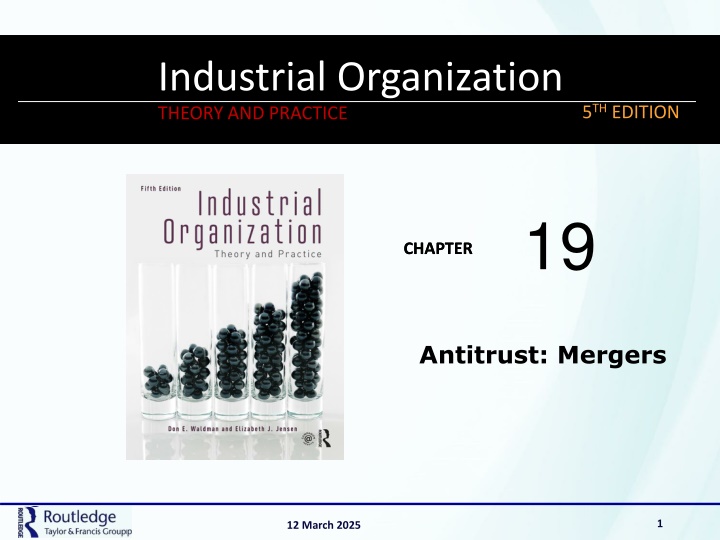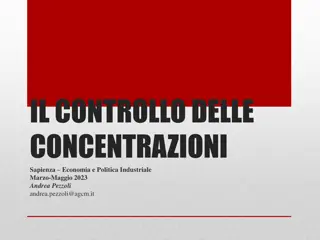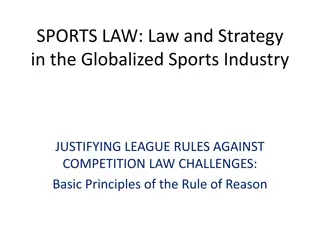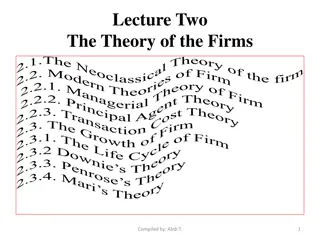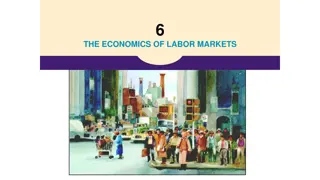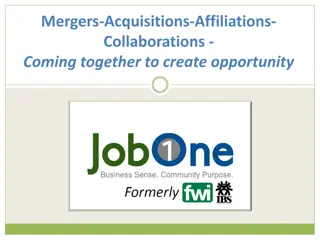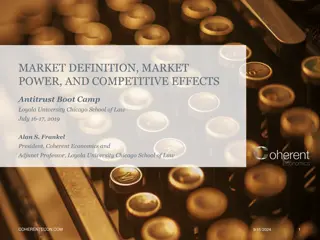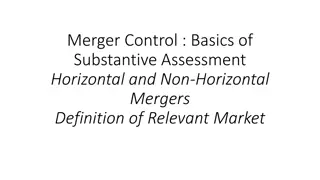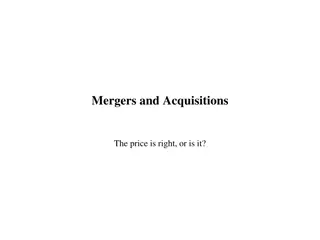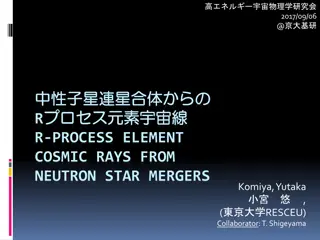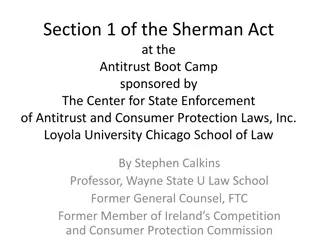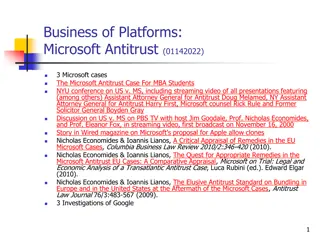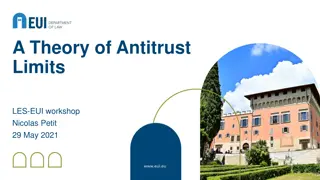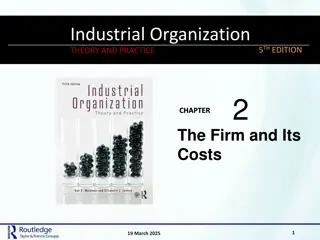Modern Labor Economics and Public Policy: Antitrust Mergers Theory
Dive into the evolution of policies governing horizontal mergers, from pre-1950 to the enactment of the Celler-Kefauver Act in 1950. Explore landmark cases like Thatcher Manufacturing and Bethlehem Steel, shaping antitrust regulations.
Uploaded on Mar 12, 2025 | 2 Views
Download Presentation

Please find below an Image/Link to download the presentation.
The content on the website is provided AS IS for your information and personal use only. It may not be sold, licensed, or shared on other websites without obtaining consent from the author.If you encounter any issues during the download, it is possible that the publisher has removed the file from their server.
You are allowed to download the files provided on this website for personal or commercial use, subject to the condition that they are used lawfully. All files are the property of their respective owners.
The content on the website is provided AS IS for your information and personal use only. It may not be sold, licensed, or shared on other websites without obtaining consent from the author.
E N D
Presentation Transcript
MODERN LABOR ECONOMICS THEORY AND PUBLIC POLICY THEORY AND PRACTICE Industrial Organization 12THEDITION 5THEDITION 19 CHAPTER CHAPTER Antitrust: Mergers 1 12 March 2025
19.1 Public Policy Toward Mergers 19.1.1 Horizontal Mergers: Policy Before 1950 Thatcher Manufacturing(1926) Thatcher was a major glass manufacturer that acquired the stock of three direct competitors, Lockport Glass, Essex Glass, and Travis Glass. After purchasing the stock, Thatcher purchased the assets of all three companies, so that as of January 13, 1921, the three firms ceased to exist. On March 1, 1921, the FTC staff filed a complaint charging Thatcher with violating the Clayton Act. The Commission ordered Thatcher to divest all of its assets that were formerly held by the three acquired firms. The Supreme Court overturned the Commission and ruled, The Act has no application to ownership of a competitor s property and business obtained prior to any action by the Commission, even though this was brought about through stock unlawfully held. This ruling effectively meant that as long as a firm acquired the assets, rather than the stock, of a competing company, there was nothing the government could do under the Clayton Act. 12 March 2025 2
19.1 Public Policy Toward Mergers 19.1.1 Horizontal Mergers: Policy Before 1950 Horizontal Mergers: The Celler-Kefauver Act of 1950 The final major amendment to the Clayton Act occurred in 1950 with the passage of the Celler-Kefauver Act, which amended Section 7 of the Clayton Act to include mergers through asset as well as stock acquisition The Celler-Kefauver Act also extended Section 7 to reach vertical and conglomerate mergers as well as horizontal mergers. With the passage of the Celler-Kefauver Act, Section 7 of the Clayton Act finally had some clout in dealing with anticompetitive mergers. The first major ruling came in 1958 in the Bethlehem Steel decision. Bethlehem Steel (1958) On December 11, 1956, Bethlehem Steel and Youngstown Steel entered into an agreement whereby Bethlehem obtained all of Youngstown's assets. At the time of the merger, Bethlehem ranked as the nation's second largest steel maker, with a 15 percent national market share. Youngstown ranked sixth, with a 5 percent share. U.S. Steel was the nation's leading producer with approximately a 30 percent share, and the industry was highly concentrated with a four firm concentration ratio of 60 percent. 12 March 2025 3
19.1 Public Policy Toward Mergers 19.1.1 Horizontal Mergers: Policy Before 1950 Bethlehem Steel (1958), continued Bethlehem and Youngstown defended the merger on the grounds that Bethlehem and Youngstown competed in different geographic markets and that the beneficial aspects of the merger outweighed any possible negative effects because the merger would enable Bethlehem to compete more effectively against U.S. Steel. The District Court rejected both defenses. First, the Court found that in 1955 Bethlehem had shipped over 2 million tons of steel products into the Mid-Continent area, a 4.9% share of that market. Youngstown in the same year shipped 6.7 percent of total industry shipments into that region. These figures indicated that Bethlehem and Youngstown were competitors in the Mid- Continent market. As for the beneficial effects outweighing any negative effects, the Court ruled that this defense did not hold up "as a matter of law." The Court went on to state that "good motives and even demonstrable benefits are irrelevant" to the law. The Bethlehem Steel case was not appealed to the Supreme Court, but a few years later the highest court upheld its major precedents in the Brown Shoe case. 12 March 2025 4
19.1 Public Policy Toward Mergers 19.1.1 Horizontal Mergers: Policy Before 1950 Brown Shoe (1962) The Brown Shoe case established major precedents for both horizontal and vertical mergers. In 1955 Brown Shoe purchased Kinney, and each firm was both a manufacturer and retailer of shoes. Brown was the fourth largest manufacturer with a 4 percent market share, and Kinney was the twelfth largest manufacturer with a 0.5 percent share. In retailing, Kinney was the nation s largest chain retailer, operating over 400 family shoe stores, and it ranked eighth among all shoe retailers in sales. Brown was the nation s third largest shoe retailer by sales volumes. The shoe industry was highly competitive in both sectors. In manufacturing, the top 24 firms controlled only 35 percent. In retailing, there were virtually no entry barriers, and thousands of independents competed successfully against the large chains. Despite the almost perfectly competitive nature of the shoe retailing industry, the Supreme Court handed down a strong ruling against Brown Shoe. The decision was an attempt to deter future horizontal mergers, even in industries in which the potential negative effects of such mergers would be minimal. The Court ruled that because in 118 cities the combined market shares of Brown and Kinney exceeded 5 percent, the merger violated the Clayton Act. 12 March 2025 5
19.1 Public Policy Toward Mergers 19.1.1 Horizontal Mergers: Policy Before 1950 The Brown Shoe decision established the incipiency precedent with regard to horizontal mergers. The incipiency precedent suggested that horizontal mergers should be banned even in competitive markets to prevent future increases in concentration. Philadelphia National Bank (1964) In November 1960, the Philadelphia National Bank (PNB) attempted to acquire the Girard Trust Corn Exchange Bank (Girard). The two banks ranked second and third, respectively, among Philadelphia s 42 commercial banks, and the merger would have created the largest bank in the area. Had the merger been approved, the four-firm concentration ratio in Philadelphia would have risen to 78 percent, a highly concentrated market. The Supreme Court held that the 30 percent combined market share of PNB and Girard Trust went well beyond the legal limit for a horizontal merger. 12 March 2025 6
19.1 Public Policy Toward Mergers 19.1.1 Horizontal Mergers: Policy Before 1950 The PNB decision, combined with the Brown Shoe decision, made horizontal mergers almost per se illegal under the Supreme Court leadership of Chief Justice Warren during the 1960s. A more conservative Supreme Court under the leadership of Chief Justice Warren Burger in the 1970s, however, took a more lenient attitude. General Dynamics (1974) Material Service Corporation was a large midwestern producer of coal and other materials. In 1954 Material Service began purchasing the stock of United Electric Coal, eventually enabling them to control United Electric. When General Dynamics acquired Material Service in 1959, it acquired the nation s fifth largest coal producer. The Justice Department s complaint contended that Material Service s acquisition of United Electric substantially reduced competition in two geographic markets At the time of the merger, Material Service ranked as the second largest producer in both submarkets, with a 7.6 percent share in the Eastern Province, and a 15.1 percent share in Illinois. United Electric ranked sixth in the Eastern Province, with a 4.8 percent share, and it ranked fifth in Illinois with an 8.1 percent share. 12 March 2025 7
19.1 Public Policy Toward Mergers 19.1.1 Horizontal Mergers: Policy Before 1950 General Dynamics (1974), continued The defense argued that despite these market share figures, the merger was justified on two grounds. First, United Electric had only a small quantity of reserves, and therefore, without a buyer, United would cease to be a significant competitive factor in the future. Second, because United Electric operated only strip mines, it competed in an entirely different market from Material Service, which operated only deep-shaft mines. The Supreme Court accepted both defenses and found for General Dynamics. By 1984 the courts had moved even farther away from their strict interpretation of the 1960s, as indicated by the Second Circuit Court of Appeals decision in the Waste Management case. Waste Management (1984) In 1980 Waste Management acquired Waste Resources. The two firms provided waste disposal services in many states, but the case revolved around the effect of the merger in Dallas, Texas. T he District Court found that the two firms had a combined 48.8 percent share of the relevant waste disposal market in Dallas and that under the PNB precedent the merger should be dissolved. The Court of Appeals reversed based on an argument that entry barriers were so low that even a firm with a 48.8 percent market share could not permanently raise prices above competitive levels. 12 March 2025 8
19.1 Public Policy Toward Mergers 19.1.1 Horizontal Mergers: Policy Before 1950 Elders Grain (1989) On June 5, 1988, Illinois Cereal Mills (ICM), a leading producer of dry industrial corn used in the manufacture of corn flakes, corn bread, doughnuts, and other food products, purchased a rival, the Lincoln Grain Company, from Elders Grain. At the time of the acquisition ICM and Lincoln ranked second and fifth, respectively, in sales of industrial dry corn. The merger made ICM the leading producer with a 32 percent market share, and there were only four other manufacturers of industrial dry corn in the United States. ICM had taken a series of legal actions to try to prevent the FTC from prohibiting the merger. On June 3, 1988, the FTC informed ICM that it intended to challenge the acquisition, but ICM went ahead with the merger anyway. The District Court and the Appeals Court both ruled that the merger had to be rescinded pending a full FTC investigation into the merger s legality. The Appeals Court based its decision on the high likelihood that the merger violated Section 7 of the Clayton Act. The Court of Appeals noted important industry characteristics: First, the industry was highly concentrated and had a history of attempting to fix prices through collusive activities. Second, entry was difficult and required a minimum of three years to design, build, and start operating a new mill. 12 March 2025 9
19.1 Public Policy Toward Mergers 19.1.1 Horizontal Mergers: Policy Before 1950 Staples (1997) Staples opened the world s first office superstore (OSS) in 1986. A few months later Office Depot opened its first store, and shortly thereafter other OSSs started opening all over the United States. At one time there were 23 competing office superstore chains in the United States. After a period of intense competition, but by 1996 there were only three remaining OSSs: Staples, Office Depot, and Office Max. On September 4, 1996, Office Depot and Staples, the two largest OSSs, announced they had reached a merger agreement. The FTC argued that the merger would decrease competition in the market for consumable office supplies that were sold through office superstores. The FTC s market definition thus excluded consumable office supplies that were not sold in office superstores. For example, office supplies sold at Wal-Mart, Kmart, and small office supply stores were excluded from the FTC s market definition. Based on this market definition, after the merger, Office Depot and Staples would have a dominant market share of between 45 and 100 percent in many geographic markets. 12 March 2025 10
19.1 Public Policy Toward Mergers 19.1.1 Horizontal Mergers: Policy Before 1950 Staples (1997), continued The FTC recognized that because of increased economies of scale and scope, prices might decrease after the merger; however, the Commission argued that prices would decrease even more in the absence of the merger. The FTC presented a great deal of evidence comparing prices of the same product sold under different competitive conditions. For example, file folders were priced at $1.95 in Orlando, Florida, where Office Depot competed with Office Max and Staples, but the same files sold for $4.17 just 50 miles away in Leesburg, Florida, where Office Depot competed only with Office Max. In March 1997 the Federal Trade Commission voted 4 1 to oppose the merger because it would harm competition and lead to higher prices. After the FTC vote, the FTC staff negotiated a tentative settlement with Office Depot and Staples whereby the merged companies would agree to divest 63 of their stores to Office Max in cities where Office Depot and Staples were the only two OSSs. The settlement, however, was rejected by the full Commission. Office Depot appealed the FTC ruling, but on June 30, 1997, Judge Thomas F. Hogan of the United States District Court for the District of Columbia granted a preliminary injunction to prevent the merger. This put an end to Office Depot s and Staples attempt to merge. 12 March 2025 11
19.1 Public Policy Toward Mergers 19.1. Horizontal Mergers: Policy Before 1950 Despite the General Dynamics and Waste Management decisions, horizontal mergers remain an area in which the antitrust laws hold some punch. It is doubtful, for example, that the Supreme Court would permit a merger between two dominant firms in a highly concentrated market. However, the modern trend in the lower courts today is to recognize cost-saving efficiencies as a defense in horizontal mergers. This approach is a more flexible one, allowing consideration of more factors that are relevant to an analysis of competitive effects. Also, there is no longer a Supreme Court majority that believes in the incipiency argument, and a merger between two small firms would be permitted. As a result of this change in regulatory policy, many large mergers have been permitted in recent years. Not all horizontal mergers have been approved: in March of 2011 AT&T announced plans to acquire T-Mobile USA. The Department of Justice filed an antitrust suit to prevent the merger on the grounds that the merger would significantly reduce competition. AT&T decided to fight the Department of Justice in court. While this might have been the first major merger case to go to trial in several decades, on December 19, 2011, AT&T withdrew its bid for T-Mobile. 12 March 2025 12
19.1 Public Policy Toward Mergers 19.1.2 Vertical Mergers For some time, economists, antitrust authorities, and the courts have recognized that vertical mergers are less likely to have anticompetitive effects than horizontal mergers, although they can increase entry barriers and the probability of collusion. From a legal standpoint, vertical merger cases have dealt primarily with one issue: foreclosure. Du Pont General Motors (1957) In 1917, before General Motors became the dominant automobile producer, Du Pont began to acquire General Motors stock, until by 1919, Du Pont controlled 23 percent of GM. Thirty years later, in 1949, the Justice Department filed a complaint under the Clayton Act charging that Du Pont s stock interest in GM foreclosed other firms from the market for paints and fabrics used by General Motors. Du Pont contended that the government s market definition was incorrect, because automobile and appliance paints and fabrics made up a very small percentage of the total paint and fabric market, plus, despite the stock link, General Motors often bought paints and fabrics from other companies besides Du Pont. Finally, Du Pont raised the obvious issue of timing. Could the government file a Section 7 case 30 years after the alleged violation? In 1957, 40 years after the stock acquisition, the Supreme Court ruled that the link between Du Pont and General Motors violated the Clayton Act. In 1961 the Supreme Court ordered Du Pont to divest its General Motors stock. By then 44 years had elapsed since the original stock acquisition. 12 March 2025 13
19.1 Public Policy Toward Mergers 19.1.2 Vertical Mergers Brown ShoeRevisited (1962) The Brown Shoe case involved a merger between the nation s fourth largest shoe manufacturer, Brown, and one of the nation s leading retailers, Kinney. Evidence suggested that after the merger Kinney had significantly increased its purchases of Brown shoes. In a highly competitive market, however, it is doubtful that this had any significant economic impact. Nevertheless, the Supreme Court ruled that the vertical elements of the merger violated the Clayton Act. The Court s majority stated: [W]e cannot fail to recognize Congress desire to promote competition through the protection of viable, small, locally owned businesses. Congress appreciated that occasional higher costs and prices might result from the maintenance of fragmented industries and markets. It resolved these competing considerations in favor of decentralization. In this portion of the decision, the Court made a purposeful choice in favor of maintaining a large number of firms regardless of the effect on prices and costs, placing a priority on social goals (a large number of small firms) over efficiency goals (lower prices and costs). The Du Pont and Brown Shoe precedents suggested that vertical mergers violated Section 7 as long as a reasonable probability of foreclosure existed. 12 March 2025 14
19.1 Public Policy Toward Mergers 19.1.2 Vertical Mergers Fruehauf (1989) In the 1970s Fruehauf was the nation s leading producer of truck trailers with a 25 percent market share, and the four-firm concentration ratio in the truck trailer market was 49. Fruehauf acquired Kelsey, a leading manufacturer of heavy-duty wheels used in the manufacture of truck trailers. Kelsey held a 15 percent market share, and the market for heavy-duty wheels was highly concentrated with a four-firm concentration ratio of approximately 70. The Federal Trade Commission ruled that the merger foreclosed a maximum of 5.8 percent of the heavy-duty wheel market and that the percentage violated Section 7 of the Clayton Act. The Court of Appeals recognized the likelihood of some foreclosure, but reversed the FTC. According to the Appeals Court, no evidence showed that as a result of the merger competing buyers of heavy-duty wheels would be unable to obtain supplies from Kelsey or its competitors at competitive prices, or that entry into the truck trailer market would require simultaneous entry into the heavy-duty wheel market. The Court further concluded that Fruehauf was never a serious potential entrant into the manufacturing of heavy-duty wheels. The Fruehauf decision suggests that under a more recent interpretation of Section 7, the courts are likely to look at far more than the percentage of the market foreclosed by a vertical merger. In the Fruehauf case the Court closely examined all of the expected competitive impacts of the merger and concluded that there was a very small probability of significant anticompetitive effects. 12 March 2025 15
19.1 Public Policy Toward Mergers 19.1.2 Vertical Mergers Comcast-NBC Universal Merger (2011) In December 2009, Comcast announced its intention to purchase NBC Universal (NBCU). Comcast was the United States leading provider of cable television, Internet, and telephone services with 23.8 million subscribers in 39 states. Comcast dominated six major markets with market shares of 62.9 percent in Philadelphia; 60.8 percent in Chicago; 57.2 percent in San Francisco-Oakland; 52.8 percent in Miami-Ft. Lauderdale; 44.8 percent in Washington DC; and 38.9 percent in Hartford-New Haven. Comcast, however, controlled only 9.5 percent of the market in New York City; and it did not compete in many other major market including Los Angeles, Dallas, and San Diego. Comcast s cable national market share was 23.6 percent. Comcast also owned a number of cable programming networks, including E! Entertainment, Versus (now branded as NBS Sports Network), Style, The Golf Channel, and nine regional sports networks. NBC Universal was a major provider of entertainment content and a major provider of video programming. In addition to the NBC television network, it owned many of the most popular cable networks, including USA, SyFi, Bravo, MSNBC, Oxygen, CNBC, and the nation s second largest Spanish speaking network Telemundo. Finally, NBCU owned a one-third interest in Hulu, a leading provider of online video programming. 12 March 2025 16
19.1 Public Policy Toward Mergers 19.1.2 Vertical Mergers Comcast-NBC Universal Merger (2011), continued The merger was primarily a vertical merger between Comcast s cable distribution system and NBCU s cable programming networks. There were, however, two horizontal aspects to the merger. As noted above, at the programming level, both companies owned cable networks that would be combined into one larger network. At the distribution level, NBU s one-third interest in Hulu video streaming service was increasingly in direct competition with Comcast s cable services. Both the Federal Communications Commission (FCC) and the Department of Justice examined the potential anticompetitive effects of the merger and weighed these effects against Comcast s claimed positive efficiency gains. Comcast argued that the merger would increase its rate of technological advance by improving its coordination between its creative and distribution services. Comcast also claimed that the merger would provide efficiencies by solving the double marginalization problem associated with vertical relationships. The FCC and the DOJ concluded that there were no significant efficiency gains, and certainly not sufficient gains to overcome the potential anticompetitive effects of the merger. Nonetheless, the FCC and DOJ permitted the merger subject to a number of conditions that were aimed at reducing any potential anticompetitive effects. These restrictions would expire after seven years. 12 March 2025 17
19.1 Public Policy Toward Mergers 19.1.2 Vertical Mergers Comcast-NBC Universal Merger (2011), continued These restrictions were as follows: 1. To protect other Multichannel Video Programming Distributors (MVPDs), Comcast was required to agree to binding arbitration with regard to the price charged for its programming. 2. Comcast was required to make its video programing available to online video distributors (OVDs), such as Amazon and Netflix, at rates comparable to the rates Comcast charged MVPDs. 3. Comcast was required to provide nondiscriminatory treatment for all OVDs comparable to its treatment of its own online video streaming service Fancast Xfinity. 4. Comcast was required to give up any direct decision making influence over Hulu. When AT&T, which owns the largest US satellite MVPD DirecTV, moved to acquire Time Warner, which, like NBCU, was a major producer of programming for MVPDs, the court permitted the merger over the objections of the DOJ. No restrictions were placed on the consolidated firm s behavior, most likely because the restrictions on Comcast-NBCU were about to expire. The decision to permit the AT&T-Time Warner merger set off a bidding frenzy between Comcast and Disney to acquire the programming components of 21st Century Fox. The decision to permit the Comcast-NBCU merger, therefore, had major repercussions for the entire vertical structure of the entertainment and entertainment distribution industries in the United States. 12 March 2025 18
19.1 Public Policy Toward Mergers 19.1.3 Conglomerate Mergers 19.1.3.A POTENTIAL COMPETITION CASES Procter & Gamble (1967) In 1957, Procter & Gamble, the nation s leading producer of soaps and detergents, acquired Clorox, the nation s leading producer of liquid bleach. Both firms held dominant positions: Procter had a 54.4 percent share of the detergent market, and Clorox had a 48.8 percent share of the liquid bleach market. The four-firm concentration ratio was over 80 in both markets; therefore, the merger involved the leading firms in two highly concentrated and complementary markets. The government complaint charged three major negative effects of the merger. 1. The merger eliminated Procter & Gamble as a potential competitor in the liquid bleach market. 2. It further entrenched Clorox as the industry leader, because Procter, as the nation s leading advertiser, could greatly increase the advertising expenditures of Clorox. 3. The FTC argued that smaller competitors would be hesitant to compete aggressively against large, diversified Procter & Gamble. The Supreme Court ordered the merger dissolved because Procter was the most likely potential entrant into the liquid bleach market. The Court noted, however, that if Procter & Gamble had acquired a small bleach producer, and then competed aggressively with Clorox, such a toehold merger might have significantly increased the level of effective competition. 12 March 2025 19
19.1 Public Policy Toward Mergers 19.1.3.A POTENTIAL COMPETITION CASES Bendix(1970) In 1967, Bendix, a large, diversified firm specializing in the aerospace, automotive, automation, and scientific industries, acquired Fram, a leading producer of automotive, aerospace, and water filters. The complaint revolved around the automobile filter market, which was highly concentrated, with General Motors controlling 32.4 percent, Purolator 21.7 percent, and Fram 17.2 percent. Bendix held a very small 0.35 percent market share and decided that it wanted to expand into the market on a much larger scale. After some deliberation, Bendix decided it would only expand through merger, not through internal expansion. The FTC staff argued that the Bendix-Fram merger eliminated potential competition. The full Commission agreed but handed down an important ruling which stated that the FTC would be inclined to permit toehold mergers between a large potential competitor and a small non-dominant firm. In 1971, the Sixth Circuit Court of Appeals overturned the Commission s ruling, not on substance, but on a legal technicality. The Appeals Court ruled that because the FTC had failed to inform Bendix of its intention to use the toehold theory in its case, Bendix had not been given the opportunity to prepare an adequate defense. The Appeals Court did not rule on the legitimacy of the toehold theory. 12 March 2025 20
19.1 Public Policy Toward Mergers 19.1.3.A POTENTIAL COMPETITION CASES Marine Bancorporation(1974) In 1971, the National Bank of Commerce (NBC), which was a wholly owned subsidiary of Marine Bancorporation, acquired the Washington Trust Bank (WTB). The two banks operated on opposite sides of Washington, almost 300 miles apart. NBC, located in Seattle, was the State's second largest bank, and the two top Washington banks controlled 51.3 percent of the state's total deposits. WTB was the third largest bank in the Spokane area, with an 18.6 percent regional market share. The top three banks in Spokane held a 92.3 percent market share. Entry and expansion in the banking industry was tightly regulated in Washington. Some of the regulations made little economic sense; their main purpose appears to have been to protect banks from competition. Banks could not operate new branches outside of the city or town in which they competed, except by merger with another bank in another town, could not branch once it had acquired another bank s assets, and new banks could not merge for 10 years. The Supreme Court considered these regulatory restrictions and permitted the merger. The Court ruled that in states in which such stringent entry and expansion barriers exist, the potential-competition doctrine-grounded as it is on relative freedom of entry on the part of the acquiring firm will seldom bar a geographic market extension merger by a commercial bank. It is interesting to note that the Marine Bancorporation decision was handed down at the same time as the General Dynamics-United Electric decision. The two decisions point clearly toward a more lenient attitude toward mergers by a more conservative Supreme Court during the 1970s. 12 March 2025 21
19.1 Public Policy Toward Mergers 19.1.3.A POTENTIAL COMPETITION CASES Yamaha Motors (1981) In the late 1970s, Brunswick, a large, diversified manufacturer, was the second largest seller of outboard motors in the United States with a market share that ranged between 19.8 and 26 percent. Despite its position as the leading seller, Brunswick did not manufacture outboard motors. Brunswick decided to enter into a joint venture with Yamaha Motors of Japan to manufacture outboard motors in the United States. Yamaha produced outboard motors in Japan but did not sell outboard motors in the United States. Under the terms of a joint venture, two firms agree to engage in a commercial activity and share in the profits. Functionally, joint ventures have been treated as mergers under the antitrust laws because the two firms combine to engage in a joint activity exactly as they would if they merged. The Eighth Circuit Court of Appeals affirmed an FTC ruling that the joint venture violated Section 7. The Court noted that for the joint venture to violate the law it was necessary for the FTC to show that Brunswick or Yamaha had available feasible means for entering the American outboard motor market, and that those means offer[ed] a substantial likelihood of ultimately producing deconcentration of that market or other significant procompetitive effects. The Appeals Court concluded that the evidence supported a finding that the joint venture significantly reduced potential competition and therefore violated Section 7. 12 March 2025 22
19.1 Public Policy Toward Mergers 19.1.3.A POTENTIAL COMPETITION CASES Tenneco (1982) In the late 1960s and early 1970s, Tenneco had wanted to enter the shock absorber market, and it had contacted major European manufacturers concerning possible patent licensing arrangements. Tenneco then acquired a small manufacturing company that held a shock absorber patent. Tenneco then decided abruptly to change strategy and entered the shock absorber market by acquiring Monroe, a major manufacturer of shock absorbers. The FTC ruled that the acquisition violated Section 7, but the Second Circuit Court of Appeals, by a split 2 1 vote, overturned. The Second Circuit Court ruled that there was insufficient evidence that Tenneco would have entered the market de novo in the absence of its purchase of Monroe. Despite the Appeals Court s finding that [t]he record contains abundant evidence that Tenneco had both the interest and the incentive to enter the market for replacement shock absorbers, the Court ruled against the FTC. Ultimately, the Second Circuit ruling emphasized that Section 7 deals with probabilities, not ephemeral possibilities, and the Court found an insufficient probability that Tenneco would have entered the market either de novo or through a toehold acquisition. 12 March 2025 23
19.1 Public Policy Toward Mergers 19.1.3.B RECIPROCAL BUYING CASES Consolidated Foods (1964) In 1951, Consolidated Foods acquired Gentry. Consolidated Foods was a food processor, wholesaler, and retailer. Gentry produced dehydrated onions and garlic in a highly concentrated market. Basic Vegetable was the industry leader with a 58 percent share, while Gentry controlled 32 percent. The FTC complained that Consolidated had attempted to expand Gentry's market share by suggesting to its suppliers that they purchase their requirements of dehydrated onions and garlic from Gentry. Despite these suggestions, by 1958, Gentry had increased its market share only marginally to 35 percent. In a unanimous decision, however, the Supreme Court sided with the FTC, concluding that some food processors who sold to Consolidated had given their onion and garlic business to Gentry for reciprocity reasons. Gentry's behavior of contacting suppliers was so overtly an attempt to influence their purchasing patterns that the Court declared the merger illegal. Gentry's president testified that Gentry's onions and garlics were inferior, and therefore, it is questionable whether Consolidated's behavior had much of an impact. This suggests that overt attempts to influence purchasers buying habits may be enough to condemn a merger. 12 March 2025 24
19.1 Public Policy Toward Mergers 19.1.3.B RECIPROCAL BUYING CASES ITT (1970) The ITT-Grinnell case involved a charge of reciprocal buying, and therefore, it is included here, but the government's case also included complaints concerning cross-subsidization, foreclosure, and economic forbearance. The forbearance charge was particularly unique as the Justice Department claimed that such a large conglomerate merger would likely have "general anticompetitive effects" and therefore, should be prohibited. The District Court found for ITT on all counts. With regard to the forbearance charge, the Court noted that the legislative history, the statue itself and the controlling decisional law all make it clear beyond a doubt that in a Section 7 case the alleged anticompetitive effects of a merger must be examined in the context of specific product and geographic markets. The ITT case was the last major conglomerate merger case filed by the Justice Department. The Justice Department withdrew its three pending merger cases against ITT in exchange for a consent decree. Under the decree, ITT agreed to divest Grinnell's fire protection division. 12 March 2025 25
19.2 Merger Guidelines and the Hart-Scott-Rodino Act In 1968 the Justice Department issued its first set of merger guidelines. The guidelines were meant to help reduce the uncertainty regarding the legality or illegality of a particular merger. Especially with regard to horizontal mergers, the 1968 guidelines tended to be quite strict. In an industry with a four-firm concentration ratio of over 75, the guidelines suggested that the antitrust authorities would challenge any of the mergers in the table below. 12 March 2025 26
19.2 Merger Guidelines and the Hart-Scott-Rodino Act With regard to vertical mergers, the 1968 guidelines suggested that a challenge would be forthcoming: 1. if the buyer of an input made 6 percent of the total purchases of the input and the supplier of the input made 10 percent of total input sales 2. if the supplier of the input made 20 percent of total input sales 3. if the buyer of the input controlled 10 percent of its market 4. if there was a significant trend toward vertical integration in the industry. The 1968 guidelines suggested that a conglomerate merger would be challenged: 1. if the merger eliminated a main potential entrant; if the merger created a substantial possibility of reciprocal buying arrangements 2. if the merger created increased leverage for the acquired firm, such as an increased advertising advantage 3. if any of the largest 200 firms tried to acquire any other significant firm. The 1968 guidelines were in keeping with the main line of economic thinking during the 1960s and the tough policy toward mergers of the Supreme Court under Chief Justice Earl Warren. 12 March 2025 27
19.2 Merger Guidelines and the Hart-Scott-Rodino Act By the time President Reagan took office in 1980, both economic thinking and the Supreme Court s position under the leadership of Chief Justice Warren Burger had changed. Economists and the Courts had become more accepting of the economic advantages associated with mergers and less suspicious of the potential negative impacts, particularly with regard to vertical and conglomerate mergers. As a result of this new attitude, Reagan s Assistant Attorney General William Baxter presided over a major rewriting of the merger guidelines in 1982. Instead of basing the standard on traditional concentration ratio measures, the 1982 guidelines were based on the Herfindahl Index (HI). The 1982 horizontal merger guidelines suggested that the Justice Department would not challenge a merger if the postmerger industry HI would be less than 1000. If the postmerger HI would fall between 1000 and 1800, mergers causing an increase in the HI of less than 100 were unlikely to be challenged, but mergers causing an increase in the HI of more than 100 were likely to be challenged, subject to an analysis of the effects of the merger on entry barriers, the probability of collusion, and other competitive conditions. If a merger resulted in a postmerger HI greater than 1800 and caused an increase in the HI of 100, it was very likely to be challenged. If a merger resulted in a postmerger HI of more than 1800 and caused an increase in the HI of between 50 and 100, it was likely to be challenged subject to a consideration of its competitive effects. Finally, if a merger resulted in a postmerger HI of over 1800 and caused an increase in the Herfindahl of less than 50, it was unlikely to be challenged. 12 March 2025 28
19.2 Merger Guidelines and the Hart-Scott-Rodino Act The 1982 guidelines were significantly more lenient than the 1968 ones. Under the old guidelines, the Brown Shoe Kinney merger would have been a borderline case for challenge. Under the 1982 guidelines, the Brown Shoe merger would not have come close to being challenged. With regard to vertical mergers, the 1982 guidelines eliminated all mention of specific market share limitations and instead listed three requirements for consideration of a challenge to a vertical merger. 1. The merger had to make it unlikely that any entrant would enter one market (the primary market) without entering the other market (the secondary market) involved in the merger. 2. The merger had to make entry into the primary market much less likely. 3. Entry barriers and other characteristics of noncompetitive performance had to exist in the primary market. The combined effect of these requirements was to make a challenge to any vertical merger unlikely, in keeping with economists realization that vertical integration most often results in savings of transactions and other costs. The 1982 guidelines mentioned only one reason for challenging a conglomerate merger the elimination of potential competition. 1. The market had to be highly concentrated, with a Herfindahl of over 1800. 2. Entry into the market had to be difficult. 3. There had to be only a few other potential entrants into the market. 4. The market share of the acquired firm had to be at least 5 percent. 12 March 2025 29
19.2 Merger Guidelines and the Hart-Scott-Rodino Act In 1984, the Department of Justice revised the 1982 guidelines. The 1984 guidelines explicitly recognized efficiency gains as a relevant factor in the Department s decision-making process but made it clear that efficiencies were not to be considered an absolute defense but merely one factor to be considered before a final decision was reached on a particular merger. In 1992 the guidelines were revised to further deemphasize the importance of simple concentration measures and to further emphasize the impact of the merger on price and entry conditions. The 1992 guidelines made it clear that the Justice Department would not rely on simple changes in concentration measures without evidence that the merger would result in higher prices or a greater likelihood of effective collusion. Furthermore, even a merger that was likely to result in higher short-run prices would be permitted as long as the higher prices were likely to induce entry within two years. In 1997, the guidelines were revised slightly to clarify when the Justice Department would consider economies a valid defense. 12 March 2025 30
19.2 Merger Guidelines and the Hart-Scott-Rodino Act In 2010, the Department of Justice s Antitrust Division and the FTC jointly issued revised horizontal merger guidelines. One change is a focus on the anticipated effects of a merger, looking at the extent of direct competition between the products of the merging firms and how diversion of demand from one product to another might affect firms incentives in terms of pricing and other strategic variables. There is a decreased emphasis on market shares. The guidelines also recognize the importance of coordinated effects; Section 7 of the new guidelines states: A merger may diminish competition by enabling or encouraging post-merger coordinated interaction among firms in the relevant market that harms customers. Coordinated interaction involves conduct by multiple firms that is profitable for each of them only as a result of the accommodating reactions of the others. These reactions can blunt a firms incentive to offer customers better deals by undercutting the extent to which such a move would win business away from rivals. They also can enhance a firm s incentive to raise prices, by assuaging the fear that such a move would lose customers to rivals. In addition to effects on pricing, the guidelines give attention to a merger s effects on other aspects of performance, such as innovation and product variety. The guidelines explicitly note the possibility that a merger might increase barriers to entry by making it easier for the firm to engage in exclusionary tactics. 12 March 2025 31
19.2 Merger Guidelines and the Hart-Scott-Rodino Act It is important to note one other major change in antitrust enforcement that went into effect in 1976 with the passage of the Hart-Scott-Rodino Act (also known as the Antitrust Improvements Act). The Hart-Scott-Rodino Act amended Section 7 of the Clayton Act to require advance notification to the Justice Department and the FTC of any major merger. Any merger in which one firm has sales or assets of at least $100 million and the other firm has sales or assets of at least $10 million must be reported to the government at least 30 days in advance. The act requires the provision of extensive data concerning the proposed merger and gives the government time to report to the potential merger partners whether a challenge will be forthcoming. Although compliance with the Hart-Scott-Rodino Act is expensive, it has resulted in improved enforcement by enabling the government to act quickly and before the fact against proposed mergers. In fact, it is no mere coincidence that no major merger case has worked its way to the Supreme Court since the passage of the Hart-Scott-Rodino Act. 12 March 2025 32
